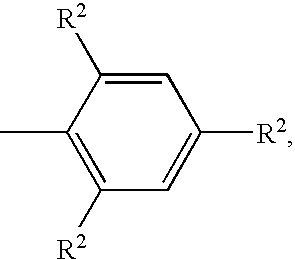Lithium batteries
a technology of lithium batteries and lithium batteries, applied in the field of electrochemical cells, can solve the problems of high discharge burden, and achieve the effect of increasing the discharge capacity of the first charge-discharge cycl
- Summary
- Abstract
- Description
- Claims
- Application Information
AI Technical Summary
Benefits of technology
Problems solved by technology
Method used
Image
Examples
example 1
[0139]Bis(methoxymethyl)polysulfide. A solution of sodium polysulfide was prepared from Na5S.9H2O (12 g) and sulfur (1.6 g) in a solvent mixture of water (20 mL) and ethanol (10 mL). To 16 mL of the sodium polysulfide solution was added chloromethyl methyl ether (3.9 g) slowly with stirring at 25-27° C. Filtration of the solid (NaCl) and extraction with ether led to the isolation of the bis(methoxymethyl)polysulfide (2.6 g) as a viscous oil. The bis(methoxymethyl)polysulfide was determined by H1 nmr to be a mixture of bis(methoxymethyl)mono-, di-, and trisulfides. Analysis of the oil gave the following results: C, 31.0%; H, 5.20%; S, 45.08%. Calculated for C4H10O2S2: C, 31.16%; H, 6.49%; S, 41.56%.
example 2
[0140]Bis(methoxyethyl)disulfide. To 8 mL of the sodium polysulfide solution of Example 1 was added 1-bromo-2-methoxy ethane (3.7 g) with stirring at 22-25° C. Extraction of the reaction mixture with ether, washing of the ethereal solution with water, and concentration gave an oil. Distillation of the oil yielded 1.0 g of bis(methoxyethyl)disulfide. Analysis of the oil gave the following results: C, 38.27%; H, 7.82%; S, 36.18%. Calculated for C6H14O2S2: C, 39.56%; H, 7.69%; S, 35.16%.
example 3
[0141]Bis(3-allyloxy-2-hydroxypropyl)trisulfide. A solution of sodium polysulfide was prepared from Na5S.9H2O (48 g) and sulfur (25.6 g) in a solvent mixture of water (40 mL) and ethanol (8 mL). This solution was added to allyl glycidyl ether (76 g) in ethanol (40 mL) containing NaHCO3 (40 g) in portions during 1.5 hours at 27-35° C. Evaporation of the ethanol was followed by extraction with ether. After drying the ethereal solution was concentrated to yield bis(3-allyloxy-2-hydroxypropyl)trisulfide (89.3 g). Analysis of the oil gave the following results: C, 44.3%; H, 5.02%; S, 28.9%. Calculated for C12H22O4S3: C, 44.16%; H, 6.80%; S, 29.42%.
PUM
| Property | Measurement | Unit |
|---|---|---|
| oxidation-reduction potential | aaaaa | aaaaa |
| oxidation-reduction potential | aaaaa | aaaaa |
| temperatures | aaaaa | aaaaa |
Abstract
Description
Claims
Application Information
 Login to View More
Login to View More - R&D
- Intellectual Property
- Life Sciences
- Materials
- Tech Scout
- Unparalleled Data Quality
- Higher Quality Content
- 60% Fewer Hallucinations
Browse by: Latest US Patents, China's latest patents, Technical Efficacy Thesaurus, Application Domain, Technology Topic, Popular Technical Reports.
© 2025 PatSnap. All rights reserved.Legal|Privacy policy|Modern Slavery Act Transparency Statement|Sitemap|About US| Contact US: help@patsnap.com



